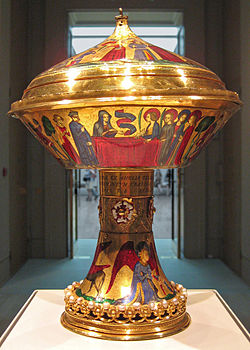Enamel (glass)
material made by fusing powdered glass to a substrate by firing
(Redirected from Porcelain enamel)
Enamel is made of melted glass, often on metal. Sometimes called vitreous or porcelain enamel, it is made by fusing powdered glass to a base by firing, usually between 750 and 850 °C (1,380 and 1,560 °F). The powder melts, flows, and then hardens to a smooth, durable coating on metal, or on glass or ceramics.[1]


- For other uses of the word, see Enamel
It has been used on decorative objects for two, or three thousand years, but especially in the Middle Ages in Europe. In the 19th century, it was used on everyday objects such as kitchen equipment and road signs. The glass is hard-wearing, scratch resistant and easy to clean.
Gallery
change-
Silver, silver gilt and painted enamel beaker, Burgundian Netherlands, c. 1425–1450, The Cloisters, nyc
-
Limoges? grisaille painted Stations of the Cross, Notre-Dame-des-Champs, Avranches
-
St. Gregory the Great in painted Limoges enamel on a copper plaque, by Jacques I Laudin
-
Louis George enamel watch dial
-
Iranian enamel
References
change- ↑ Chisholm, Hugh, ed. (1911). . Encyclopædia Britannica (11th ed.). Cambridge University Press.